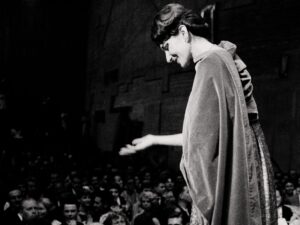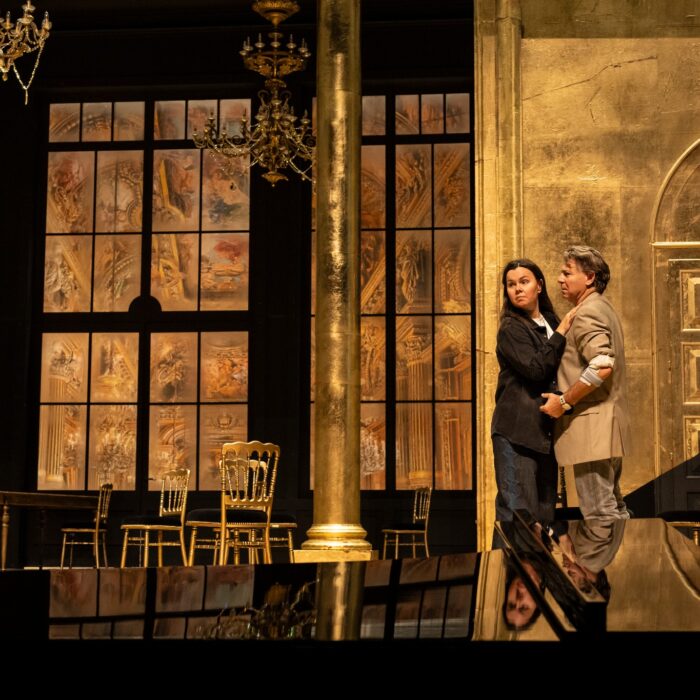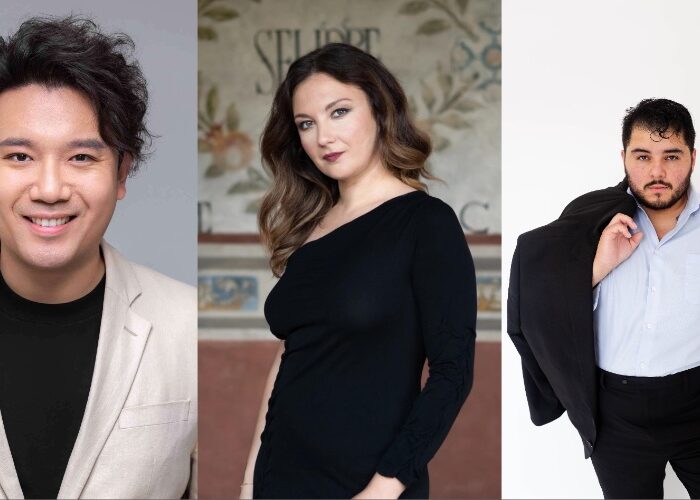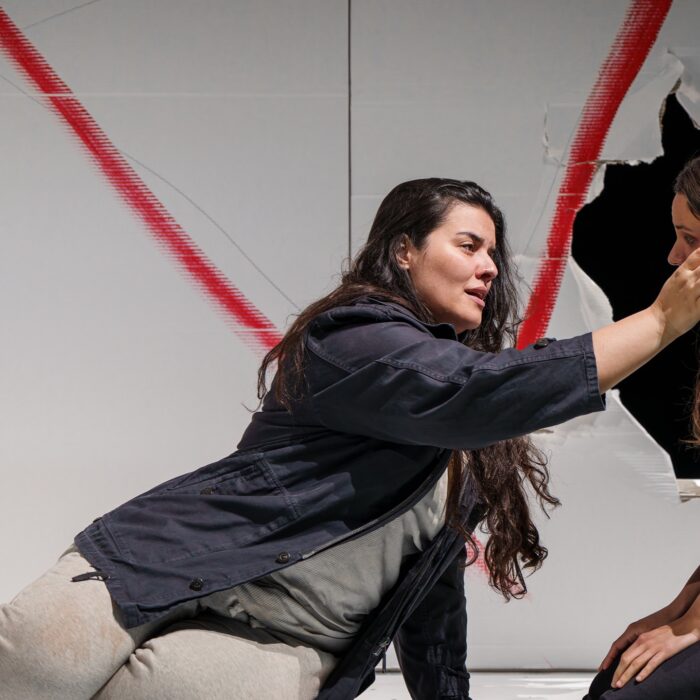
Starring ‘The Inalienable Property of Genius’: Maria Callas’ Celestial Onstage Quests
By Sophia Lambton(Callas greeting fans. Credit: © Archiv Lebeck.)
Editor’s Note: In anticipation of the release of “The Callas Imprint: A Centennial Biography” on Dec. 2, 2023, OperaWire is sharing a preview.
“Greatness” is a noun too frequently assigned to humans.
Victims of this label view the happening of “genius” as a capricious, “limited time only” gift.
Here we follow Callas on her God-given curse pursuit.
Exiled by collisions of collective flight, a stellar runaway shuns clans in spite. A fight between a quarrelsome quartet or an exploding supernova has disowned the outcast; blasting it into oblivion.
Its beams are numbered. Gleaming through galactic spheres at peak acceleration, the anomaly will soon exhaust superiority; expiring faster than its humble rivals til’ it spurs another member of their mêlée into refuge.
Lone dominos of pearl-like luminosity are these. They print their sprints across the cosmos sparsely; spreading sparks along ten million years.
It’s a rare sight.
Darkness embarks mortals’ on excursions not dissimilar. Illumining what she called “the inalienable property of genius,” Maria Callas closes herself “in a room with little light, no noise and the score at hand. I try to discover. You must hear the whole thing put together in your own head.” Notes coruscate like constellations in her consciousness; conniving to deprive the artist of a comprehensive understanding ’til she limns a composite.
“I stay by myself—for by now I know the music—that is, I no longer need the accompanist with me; I have it in my head. I could start the opera and go through, reading it as you would read a book… I have no idea yet what I shall do, but I try to feel how the character would react, what would be her typical gestures. One molds the statue: the eyes, the limbs, the whole physical impact. It becomes a stage of identification, at times so complete that I feel I am her.”
Rigor gorges itself on her sleep and leisure. The Callas self-effacement would be supervised by maestro sostituto (assistant conductor) Antonio Tonini of La Scala: “A guy I like because he is relentless: an unforgiving torturer. A kind of Dominican Order of music.
And once the masochism’s mastication had been sated; once the final test could be awaited she allowed another stab at peace. “Your mind is so confused and over-charged that you simply have to get away for a day or two,” the ponderous soprano would explain. “So I just disappear out of circulation.”
Make no mistake: enough self-torture had already slaked the Callas thirst for self-imperiling perfection. “Now… I went to Milan and saw Maria,” conductor Nicola Rescigno wrote to director of Cherubini’s “Medea,” Alexis Minotis, in September 1958.
“I have already sent you a telegram à propos of the costumes. Please tell Jean [Rosenthal] that Callas did not dislike them, but she couldn’t understand what it was all about, because the sketches aren’t sufficiently detailed. She desires to see finished sketches and please tell Jean to send them to me, air mail, as soon as possible, so that I can send them on to her. She said that she would like her costumes not quite so Greek, but a little more barbaric. She would also like a cape, which she says she needs for the numerous asides that there are in the opera; with the use of the cape, she can seclude herself from the other personages on the stage, and this is of great help to her.”
A wig was not a detail ornamental. “You see, the color choice was difficult, because when it comes to red you need to be very careful, it can grate on the eyes,” the performer explained to then-fiancé Giovanni Battista Meneghini ahead of her “Norma” debut. It was November 1948; she was in Florence. “I found a compromise between honey blond and Titian red. It’s really beautiful but wore me out. And then it must be really, really long!… Think about it: I’m super tall and with the curls it’s shorter so you want a length of 90cm so quite frankly I’ve been lucky to find it. Remember the “Tristan” wig? I couldn’t lengthen it and it was 60cm.”
Never enough. The preparatory art was a tart test of measuring capacities depletable; that finite apparatus of the voice. At a rehearsal for a concert-only rendering of “Il pirata” at Carnegie Hall in January 1959, maestro Rescigno took the stretta of the close of the first act at a rushed pace. In his words, it “required a machine gun rather than a singer. Maria looked at me a bit frightened when her solo passage was coming up, and she didn’t make it. I told her next time around I would put on the brakes just before her entry.”
‘No, don’t do that,’ she countered. ‘I like the tempo very much; it is very valid, and I don’t want you to help me.’
‘Well,’ I said, ‘what if you don’t make it in the performance?’
‘That’s my business, not yours,’ she answered.”
Inhuman instruments posed indelicious rivalry. Tackling “Lucia di Lammermoor’s” notorious cadenza, Callas combined with its flautist to mimic the stuporous ditty; rehearsing non-stop in an effort to marry the contrary species.
A horn player’s practice at Rescigno’s helm was unsolicitedly studied by her—and those Callas sermons that devolved into “an expert treatise on Bellinian phrasings and fioriture, accents on trills, the placements of breathing, and the similarities between vocal and instrumental techniques,” in the words of biographer George Jellinek.
Comrades weren’t left alone. “When there was a rehearsal at eleven, she arrived at ten thirty and did her vocalizes,” remembered tenor Luigi Alva: the Lindoro (or Count Almaviva) to her Rosina in La Scala’s February 1956 “The Barber of Seville.” “At eleven, the rehearsal began, not everyone had arrived, and that angered her…” On one occasion Callas stood aghast before two singers rabidly debating last night’s football match.
Franco Corelli would attribute his La Scala debut—Spontini’s “La vestale” under the direction of Luchino Visconti—to Callas’ clout: “I have to say that she rather protects me,” he noted. Years later she would teach him Pollione’s part—that scoundrel who’d betrayed her Norma—“phrase by phrase,” or so the legend went.
At one point during a production of “Poliuto” whose large chorus strike freed artists from their obligations, Callas isolatedly rehearsed with its director Herbert Graf.
Succumbing to indulgence late one night at a rehearsal for Visconti’s La Scala “La sonnambula,” the undeterred soprano cut herself some slack. It was two thirty am, and she sat down.
Still, humor was a must. Before a concert with the London Symphony she couldn’t help observe how “handsome” bassoon player Vernon Elliott was.
Three weeks dissolve into a week; eventually two days before and suddenly we’re at the eve of opening night. On Callas’ condition a piano must be present… quite ubiquitously. “By the way,” reported the Hamburger Abendblatt in 1962, “in her Munich hotel there were heated debates with Hans Knappertsbusch about the piano.” With the famed maestro out of town, the singer had arrived to use his house for the duration of her stay. “When ‘Kna’ heard Callas had moved in and a piano had to be set up, he vehemently argued against this disturbance of the peace.
“But the honorary citizen of Munich had to capitulate to the prima donna. He passed her grudgingly and without greeting.”
Other tales included Callas’ demand for a piano in the presidential suite of Chicago’s Sheraton-Blackstone, as well as summons for an engineer to come and remedy the “air dryness”. In Dallas one had been installed inside her dressing room, while Boston’s Ritz-Carlton Hotel let out one of her suite’s rooms—forcing the self-conscious singer to stand mattresses against her walls to soundproof them.
Intimidation would insinuate those last rehearsals. “If people watch me when I’m working I get extremely shy. Especially in rehearsals I can’t stand people looking at me. It makes me feel closed in,” she would confide.
Though rest throughout the seventy-hours that preceded an event remained her preference it was scarcely practicable. “Photographers lurk in every corner,” a Hamburg-based newspaper told. “A television truck is parked before the hotel door. Stacks of autograph albums are handed to the receptionist. Organizer Kurt Collien and record manager Jacques Leiser field questions: ‘Unfortunately, Miss Callas can’t be reached.’”
She was too busy trying to calm down in her room. Chatter was the enemy of her poetic incantations; cold a crueler foe. “She is just tired and strained from talking a lot,” Collien told. “The city’s drifting snow, the wet cold are good reasons for her self-inflicted room arrest.”
Lunchtime didn’t promise absent-mindedness. In earlier days fan Leiser had observed her walking into a café some paces from La Scala brandishing a dagger. “Maria, what are you holding in your hand?” It took the off-duty Medea a short while to notice.
Overcaution cloaked her environs. Another incarnation of “Medea” had Dallas Opera’s Founding President, Henry Miller, and Chairman of the Company’s Information Committee, William Reed, mop the stage floor in rehearsal; dust could interfere with respiration.
Melting crayons’ scent was soon upon her as the lyrical performer sat being coiffed and face-painted. In 1974 a hum buzzed from her lips: “O mio babbino caro” from Puccini’s “Gianni Schicchi” swimming through her room as hairdresser Alexandre de Paris styled her hair in a bun.
She asked if it was irking him.
“That, my dear, is like asking the Pope if God is a disturbance.”
Diamonds could be. Eschewing their bedazzling zeal, a wily Callas would emerge without a brooch onto the concert stage. “I don’t want the audience looking at jewels instead of listening to me,” she elucidated.
Such disciplinary action thankfully did not extend to her attire: “She was all done up in white silk with scarlet full-length gloves almost to her shoulder, and a red flimsy scarf about her neck, which she occasionally fiddled with,” wrote critic Henry Mitchell of her Washington DC concert of November 1958. Almost a year later spectators espied “a spotlighted cerise jacket over a black dress so tight that she looked at times to be encased in slacks…” The Guardian’s Neville Cardus ventured to describe.
Stoles and shawls and wraps would often be manoeuvered to allow for heroines recovering control, or losing it, or self-protecting in naivety.
Her cells’ activity became more heightened as the hour beckoned… almost to the point of disassociation. Contemplating playing hooky at her final Royal Opera London “Tosca” on 5 July 1965, Callas paced back and forth in her hotel room, half-joking to maestro Georges Prêtre: “Why don’t we go to the cinema?”
Getting away with faults was others’ bona-fide fait accompli; for Callas it was more than sin. “Perfection? And who believes that?” she ranted at one point in February 1960. “I’ve seen pianists celebrating an entire night of playing in the wrong key. It can happen to [Alfred] Cortot and [Annie] Fischer. Nonetheless, everyone asks me for perfection. I am always a rookie. It’s my condemnation. Starting over every night.”
In one last-minute Dallas “Medea” rehearsal a pillar onstage almost fell on her.
Ritually she’d pray before a miniature of the Madonna purchased by her husband. Superstition led her once to ask best friend Giovanna Lomazzi to return to her Milan home from Vienna and recover the untaken talisman. “Only twice have I forgotten to take it to my dressing room and on both occasions I developed severe hoarseness and couldn’t go on,” avowed Callas. “I don’t think I’m superstitious. Such things have mystic implications in our lives. I am a fatalist and firm believer in destiny.”
Conjuring the precelestial atmosphere, Callas would discern a haze of glittery reflections shimmering across the gods and wonder: “Something happens even before the performance begins… You know from looking up at the gallery of La Scala if the production will be at least somewhat successful or if it won’t be. There is a fever that comes out of that.”
Fever can pose danger. In a concert of March 1962 maestro Georges Prêtre managed to cue both his orchestra and Callas at the wrong time. Hiding out in his hotel room afterward, he was eventually comforted by his sole singer, who had sought him out. She sat beside him on his bed. “You’re an excellent conductor… It could happen to anybody.”
A rendition of “Don Carlo”‘s “Tu che le vanità” one evening in London led to Callas’ bangle falling noisily down from her wrist. With a false smile she picked it up as spectators applauded. Three years earlier in Amsterdam she had performed the aria congested, started one verse with the wrong line and begun another late.
A red-laced strap came loose from Violetta’s gown at 1958’s Met “Traviata.” “Tear the other one off, too,” Callas instructed colleague mezzo Helen Vanni.
White hot incandescence sent the starry seeds of inspiration awkwardly descending. “I love Puccini, but he is not a favorite of mine,” the soprano lamented. “His music is too down to earth.”
And yet one spotlight-despoiled night she had surrendered herself no holds barred to “Butterfly”. “Titta Meneghini [her husband] told me he got up once to observe the other half of their bed empty,” journalist Anita Pensotti elaborated. “Worried, he went around the house and looked in every angle… she was on her knees on the living room rug sobbing desperately, the ‘Madam Butterfly’ score on the floor.”
“I don’t think the geisha is right for me,” the quibbling fussbudget alerted music critic Lanfranco Rasponi in her obstinance. “I’m too tall, and all those small, mincing, miniature gestures don’t really suit my style. The music is lovely, but so sentimental, and I prefer roles that I can really get my teeth into.”
Fiction’s invitation was too redolent. Instilling herself with abandon in the geisha’s dainty steps, the artist lavished Cio-Cio-san in the sublime at the Chicago’s Lyric Opera in November 1955. Though a recording didn’t capture her vicissitudes, a studio extraction of the role at the baton of Herbert von Karajan showcased her metamorphosis.
Lieutenant Pinkerton has no respect for the fifteen-year-old—and every opera patron knows that. Yet the radiant young bride luxuriates in her illusion; loosening our cynicism to escort us on her self-deceptive trip.
“Bimba dagli occhi”—the husband and wife’s wedding night duet—lays bare the girl’s embarrassment with a still-immature timbre lining “Celarmi potessi! ne ho tanto rossor!”—“If I could only hide, I’m blushing so much!”
Scathing intonations scold her upper mind: “E ancor l’irata voce mi maledice…” “And still the angry voice condemns me…” she reflects before admonishing: “Butterfly! rinnegata! rinnegata… e… felice…” (“Butterfly! Given up [to marriage], given up and… happy”). The dip into a diffident diminuendo on the portamento in “felice” presupposes travesty; a premonition of the lethal fate to come.
But it’s her wedding night. Joy must emerge triumphant, even if her blaze of glory feels unearned. As she refers to “the moon goddess who captivates all hearts… and carries them away to higher regions,” (“e via se li reca negli alti reami”), her instrument steers muster into “reca” before backing charily away in a diminuendo swoop over “reami”: happiness’ palpable alarm.
Ecstasy exhilarates—and simultaneously accelerates—the exit of “per tema d’averne a morir”: “for fear of dying from it.” Cio-Cio-san’s exuberance inelegantly overspills. “L’amor non uccide”—“Love doesn’t kill,” assures astucious Pinkerton, but every conflict between Callas’ expressly flimsy timbre and crescendos over shooting notes is a climactic fusion of delirium and humility; felicity and fear.
Death was its prophecy. Unclipping the long pins asprawl throughout her hair at the Chicago “Butterfly,” the adolescent mother killed herself in hara-kiri as her locks came floating down.
A geisha given up.
Leontyne Price—then just a juvenile soprano in the audience—later attributed her catching of the “opera bug” to such a spectacle.
Concerts’ closure would be crowned with poise. In one oft-seen clip she conveys a hand of two curled fingers, two relaxed; applies it to her lips and offers her still-adulating audience an adoring kiss. The moment came up in a 1997 Steve Jobs-curated Apple campaign titled “Think Different.” “Here’s to the crazy ones…” it toasts, including Callas in the ranks of Albert Einstein, Pablo Picasso, Nelson Mandela et al.
A sage-green gown would be enveloped with red roses. At the concert of September 23, 1959, she handed one to Hugh Maguire, leader of the London Symphony Orchestra.
Bouquets rocked her arms aboard a bus as she sat traveling across an airport terminal the following morning.
Post-performance nonetheless the public would be all-encumbering. A fan appeared and reappeared at her stage-door throughout a run of “La sonnambula.” “Didn’t I see you at the premiere?” she questioned. “Yes.”—“And you’re back again?”—“Yes, and I’ll be here tomorrow as well.”
To her admirer Dolores Rivellino she extended a huge bottle filled with orange soda, offering a sip. “We shook our heads ‘No’,” wrote the former, “although I would’ve sold [my friend] Herb for a swig…”
The mob accosted her with flapping headshots often until two or three at night.
Released from their consumption, she would come across more unexpected fans. En route to his car, ex-president Harry Truman caught up with the soprano to relay more praise. “You know,” he expressed in breathlessness to friend and critic Paul Hume minutes later, “she remembered me!”
But it was not enough. “It has happened to me sometimes that I have come home after a performance which has been wildly applauded—and I’ve cried bitterly because I knew I’d been unable to serve that composer as I felt he intended,” Callas would expose. “I may have taken a few steps in the right direction, but those few steps had only made me see how much farther one really needed to go.”
Inspired stars would pop before their time; genius’ spark she hungered to divine.
So she would work in wait.
The Callas Imprint: A Centennial Biography will be released on her birthday, 2 December.
Pre-order now and stay tuned for sneak peeks.
Sources in order of sequence:
“Science Release: Enigma of Runaway Stars Solved,” European Southern Observatory, 14 January 1997. Accessed here.
“Nada para mim foi fácil”: Unsigned interview with Callas reproduced likely from another publication in Jornal do Brasil, 2 February 1960. Accessed here.
“From Our Special Correspondent: Mme. Callas on Opera,” The Times, 22 June 1959.
D. Prouse, “Maria Callas Speaks,” The Observer, 19 March 1961.
“Nada para mim foi fácil”: Unsigned interview with Callas.
Prouse, “Maria Callas Speaks.”
Nicola Rescigno to Alexis Minotis, 2 September 1958 [Alexis Minotis Papers, The Katina Paxinou and Alexis Minotis Archive | National Bank of Greece Cultural Foundation‒Hellenic Literary and Historical Archive (MIET‒ELIA)].
Callas to Giovanni Battista Meneghini, 18 November 1948 in Renzo Allegri, Maria Callas: Lettere d’amore (Milan: Mondadori, 2008), 96.
J. Ardoin & G. Fitzgerald, Callas: The Art and the Life (New York: Holt, Rinehart and Winston, 1974), 22.
R. Dassoni, Interview with Maria Francesca Siciliani in Dassoni, My Callas, https://www.fondazionepollistoppani.it/my-callas-2023, 10:06–10:32.
G. Jellinek, Callas: Portrait of a Prima Donna (New York: Dover Publications, New Edition, 1986), 335.
G. Farret, Luigi Alva, L’Almaviva de la Scala (Gémenos: Éditions Autres Temps, 2010), 84.
Foreword by Montserrat Caballé in David Bret, The Tigress and the Lamb (London: Robson Books Ltd, 1999), xii.
U.R., “Corelli fa le bizze a Parigi vuole il nome come la Callas,” Il Gazzettino Venezia, 4 June 1964.
F. Rizzo, “The Callas Class,” Opera News, April 15, 1972.
P. Hoffer, “It Was Callas’ Night At La Scala,” Music and Musicians, January 1961
P. Desgraupes, L’invité du dimanche, ORTF-TV, 20 April 1969.
J. Pilgrim, “Obituary: Vernon Elliott,” The Independent, 30 November 1996.
“Schlechtes Wetter, gute Laune,” Hamburger Abendblatt, 15 March 1962.
J. Conway, “Callas’ Note Pianissimo?,” The Washington Post, 21 January 1958.
F. Zeffirelli, Zeffirelli: An Autobiography (London: Weidenfeld & Nicholson, 1986), 150–51.
R. Sutherland, “Callas: Diary of a world tour—2,” The Sunday Telegraph, 7 September 1980.
D. Prouse, “Maria Callas Speaks.”
“Schlechtes Wetter, gute Laune.”
J. Leiser, “Exclusive: My Life with Maria Callas”: Excerpts from Jacques Leiser: A Life Among Legends: An Impresario Looks Back, slippeddisc.com, 31 May 2016. Accessed here.
L. Davis, La Scala West: The Dallas Opera Under Kelly and Rescigno (Dallas: Southern Methodist University Press, 2001), 33.
M. Christy, “The Voice Next Door”: Boston Globe, 4 March 1974.
“Callas Dazzles—Without Gems,” The Washington Post, 30 January 1959.
H. Mitchell, “La Callas Descends Upon Washington,” The Washington Post, 25 February 1974.
N. Cardus, “Maria Callas at the Royal Festival Hall,” The Guardian, 28 February 1962.
G. Prêtre, La Symphonie d’une vie: Entretiens avec Isabelle Prêtre (Paris: Écriture, 2013), 129.
“Nada para mim foi fácil”: Unsigned interview with Callas.
J. Williams, Jon Vickers: A Hero’s Life (Boston: Northeastern University Press, 2007), 91.
G. Lomazzi, “Della Madre Preferisce Non Dir Niente: Tutta La Sua Tenerezza E’ Per Il Padre,” La Settimana Incom, 23 February 1961.
“I’m A Fatalist Says Prima Donna,” The Toronto Daily Star, 21 October 1958.
D. Ossenska, Interview with Callas for La Scala e i suoi protagonisti: Documentary aired on RAI Television, 23 March 1975.
J. Leiser, “Exclusive: My Life with Maria Callas”: Excerpts from Jacques Leiser: A Life Among Legends: An Impresario Looks Back.
A Golden Hour from the Royal Opera House: 4 November 1962 Concert of Callas released on BluRay by Warner Classics as “Maria Callas in Concert,” Warner Classics, 15 September 2017.
Callas’ Holland Festival Concert in Amsterdam, 11 July 1959, released on Maria Callas: Live in Amsterdam 1959, EMI Records, 2003.
T. Villecco, “Helen Vanni, The Met’s Invaluable Trouper,” Classical Singer, 1 September 2014.
J. Ardoin,“Callas Today,” Musical America, 1964. Accessed here.
A. Pensotti, “Maria Callas” in B. Tosi, Giovane Callas, (Venice: Maria Callas Associazione Culturale, 1997), 33.
L. Rasponi, The Last Prima Donnas (New York: Limelight Editions, 1998), 583.
Lomazzi, “Della Madre Preferisce Non Dir Niente: Tutta La Sua Tenerezza E’ Per Il Padre.”
National Endowment for the Arts, Interview with Leontyne Price, 3 June 2010, https://www.arts.gov/stories/video/nea-opera-honors-interview-leontyne-price, 10:48–13:00.
P. Cater, “Callas Gets A £250,000 Offer,” Daily Mail, 24 September 1959.
J. Carpenter, “The Tigress (just plain Maria) goes out like a lamb,” The Evening News, 24 September 1959.
J. Leiser, “Exclusive: My Life with Maria Callas”: Excerpts from Jacques Leiser: A Life Among Legends: An Impresario Looks Back.
D. Rivellino, The Malibu Cookbook: A Memoir by THE GODMOTHER OF MALIBU (Bloomington: AuthorHouse, 2007), 44.
R Allegri, Maria Callas: Lettere d’amore (Milan: Mondadori, 2008), 88.
B. Burnes, Harry S. Truman: His Life and Times (Kansas City: Kansas City Star Books, 2003), 15.
D. Prouse, “Maria Callas Speaks.”
Categories
Special Features


